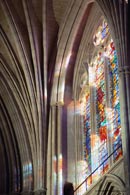|

St. Thomas was born in Galilee. He was one of the twelve Apostles of Jesus Christ. St. Thomas is also known as the Apostle of India; the Twin; Doubting Thomas; and also Didymus. In John 11:16, he was identified as
"Thomas, who is called Twin." He is called Judas Thomas (Judas the Twin) by the Syrians. St. Thomas is mentioned in all four Gospels of the Bible, but his character is outlined mainly in the Gospel according to John.
The phrase "doubting Thomas" was given to St. Thomas after a famous event that has occurred in his life. In John 20: 19-29, he was not among those disciples to whom the risen Christ first appeared, and when they told the
incredulous Thomas, he requested physical proof of the Resurrection of Jesus Christ. St. Thomas said, "Unless I see in His hands the prints of the nails, and put my finger into the print of the nails, and put my hand into His side,
I will not believe" (John 20:25).
Thomas was fulfilled when Jesus Christ reappeared and specifically asked St. Thomas to touch his wounds. Christ said to Thomas, "Reach your finger here, and look at My hands; and reach your hand here, and put it into My side.
Do not be unbelieving, but be believing" (John 20:27). When Thomas realized that what he had heard about Jesus Christ's resurrection was true, he cried, "My Lord and my God!"(John 20:28). His sudden realization of the truth made
St. Thomas the first person to explicitly acknowledge Christ's divinity. Was it wrong that St. Thomas doubted the other disciples when they said that they have seen the Lord alive? This fact of Jesus Christ being alive, after being crucified,would have been hard for anyone to accept. In essence, St. Thomas decided to suspend his belief until he had seen for himself the nail prints in Christ's hands.
But when St. Thomas saw Jesus, he needed no more proof.
It's not wrong to suspend our belief at times, as long as, like St.Thomas, we are willing to experience Christ for ourselves and see the truth.
Invite Jesus into your life, follow Him daily, and every doubt that you have will go away. According to the 4th century Ecclesiastical History of Bishop Eusebius of
Caesarea, St. Thomas evangelized Parthia. Later, St. Thomas extended his apostolate into India, where he is recognized as the founder of the Church of the Syrian Malabar Christians, also known as the Christians of St. Thomas.
St. Thomas is considered to be the Patron Saint of India. He set foot in India in AD 52. The Syriac-rite Christians of Malabar in India, whose Church was established by the 3rd century, claim St. Thomas as their founder.
St. Thomas founded the Malankara Orthodox Church of India in AD 52. He established seven churches and one chapel. The seven churches are located in the following areas: Niranam, Gokkamangalam, Kodungallur, Paravur, Nilackal (Chayal), Kolam (Quilon), and also Palur (Palayur).
St. Thomas' martyrdom was cited under the king of Mylapore at Madras, where the St. Thomas Mount and San Thome' Cathedral, his traditional burial place, is located. St. Thomas died in AD 72, in India. He was stabbed to
death with a spear. His remains were believed to have been taken to the West and enshrined in Ortona, Italy.
St. Thomas' feast day is the day of the transference of his body to Edessa. It is celebrated on July 3 in the Syrian and Roman Catholic churches, October 6 in the Orthodox Church, and December 21 in the Anglican Church. St. Thomas is well known today all around the world, especially in India, because he was the one who brought the religion of Christianity into India.
|


